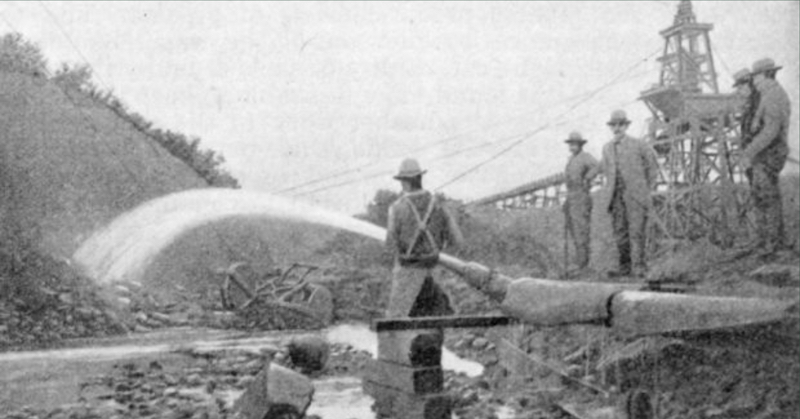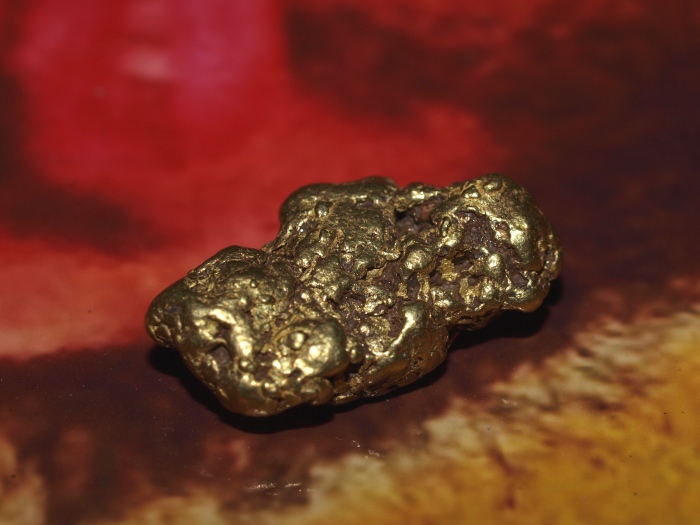
One thing that surprises a lot of beginners is that nearly all of the richest gold mining areas have already been found and mined. The cream-of-the-crop is long gone… the old-timers already found it.
Now that isn’t to say that you can’t still go out and find gold today. Not by a long shot. What it does mean is that your time is best spent looking in areas that are already historically known to have gold. Look for the places that have already been mined, not some new undiscovered paradise of hidden treasures.
There is plenty of gold left, but you have to know the best way to find it. We’re going to dig a little deeper on this subject.
Gold Rushes: From 1849 and Beyond
Most people who prospect for gold nowadays consider it as a hobby. They aren’t dependent on the gold they find to pay the bills. In fact, most prospectors would be lucky to find enough gold to even pay for gas money.
During the early days of the gold rushes throughout the Western U.S. this was far from the case. Men traveled from across the globe in hopes of getting rich. They worked hard, and even if they were able to recover decent gold many of them still couldn’t make enough to live comfortably.
When someone stuck gold in a location, word would get out and usually thousands of miners would descend on an area. There wasn’t a single creek that wasn’t panned, and nary a rock left unturned in the search for the elusive yellow metal. There are many areas that you might visit today that seem completely desolate and abandoned, but 150 years ago they many have been booming with thousands of prospectors.

Secret Rivers Full of Gold
Sadly, what I’m telling you is that you aren’t likely to come across some secret creek deep in the forest that has sat undiscovered for centuries. There aren’t really any true “secret” spots left in my eyes. Yes there is certainly plenty of gold that was missed by the old-timers, and there are even some small deposits that where overlooked completely. But you won’t find them without focusing on the known gold districts first (more on this later).
In recent years, the closest I have seen to a true, genuine gold rushes have occurred in places like Sudan and the Democratic Republic of Congo where war and conflict have limited the ability for exploration. Even in these areas, the gold strikes aren’t really new. It was generally access that limited the mining activity, not that the source of gold was actually unknown.

Hit the Known Locations
When I go out prospecting, I am always in areas that are already known to have gold. Nearly all of these places were first discovered in the 1850s and 1860s. These aren’t new area, but they are often forgotten. There has been mining activity going on here, off and on, for over 150 years.
You won’t find me just wandering the forest or desert aimlessly searching for gold. I like to metal detect for gold nuggets, and the first necessity for doing it successfully is to be in an area where gold nuggets exist. And the truth is that on 99% of the land there simple aren’t any gold nuggets. If you want to be successful, you have to put yourself where the gold is.
The old-timers put in a lot of work finding these gold-bearing areas. You should take advantage of their efforts by researching the areas that they mined. There are lots of great books that discuss mining history and ghost towns. With a little bit of effort it’s not hard to find these places.
Trust me, if there was ever gold there, then there’s still some gold left behind. With a little effort you can find some of it.
Tactics to Find Prospecting Spots Outside of Known Areas
After having said all that, now I’m going to say something that will sound a bit contradictory. YES by all means venture out and explore new areas. Explore outside of the known mining areas. Explore ground that hasn’t been mined and still appears untouched.
There are certainly locations that the old-timers simply missed, or perhaps ignored because they weren’t rich enough at the time to warrant much effort. You can still find these areas, and they can be very rich and very productive, but I highly recommend that you look near the known mining areas.
I have personally found gold as far as 10 miles away from any gold district. But most of the time I am within 1 miles or less of an established mining site, whether it be a hydraulic mine, dredge tailings, or underground hard rock mine.
When I locate indicators that the old-timers were digging, I know that gold is present. Of course you should spend some time right there and see if there was anything left behind. Right on top of historic diggin’s is often the best spot to be.
If I decide to explore I will look at adjacent areas. Perhaps I will walk uphill within the same drainage and try to locate an exposed vein or contact point. Maybe I will walk over a ridge and explore a small creek with no clear indication that it was mined. No water? I might collect a 5-gallon bucket of pay dirt and hike down to the nearest water to pan it out and see if there is any gold in it.
You can definitely find great prospecting locations that have been missed by prospectors. Just keep in mind that there is a benefit to learning from their efforts and experience.
Stay close to the known areas. Wandering aimlessly across the land hoping you will stumble onto the holy grail of prospecting locations will end in failure. Spend time learning hunting in and around known mining areas will be more productive. You many very well have some luck and find a nice source of gold that was never unearthed, but it won’t happen by accident. Do your research and increase your chances of success.
Also Read:
Metal Detect the “Fringe” Spots to Find More Gold
Gold Prospecting a Different Way | Get out of the Water!
Safety While Prospecting in the Backcountry
